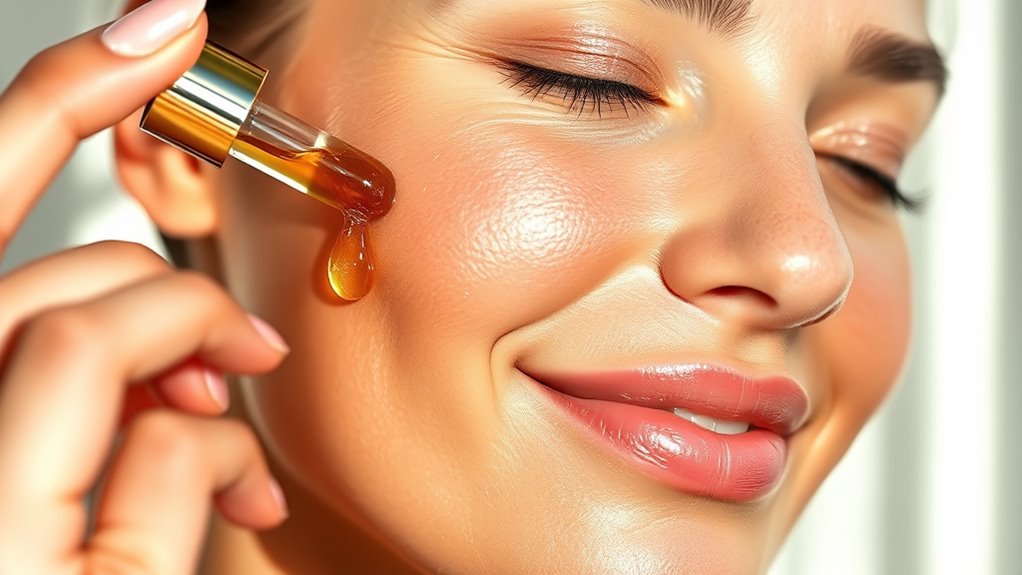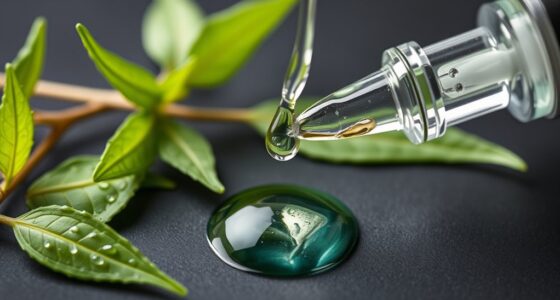Facial oils can actually be a secret weapon for oily skin because they help balance your sebum production rather than clog your pores. When you use the right lightweight, non-comedogenic oils, they signal your skin to produce less oil, calming overactive glands. Properly chosen oils restore harmony and reinforce your skin’s natural barrier, reducing shine and breakouts. If you want to learn how to harness these benefits effectively, there’s more to discover below.
Key Takeaways
- Facial oils help regulate excess sebum by signaling oil glands to produce balanced amounts, reducing shine and pore clogging.
- Non-comedogenic oils mimic natural sebum, preventing breakouts while maintaining skin hydration.
- They soothe inflammation and irritation, calming overactive oil production and promoting healthier skin.
- Properly selected facial oils restore skin barrier function, reducing sensitivity and preventing oil overproduction.
- Hydrating oils prevent dehydration-related oil spikes, supporting a balanced, less greasy complexion.
Understanding Oily Skin and Its Challenges
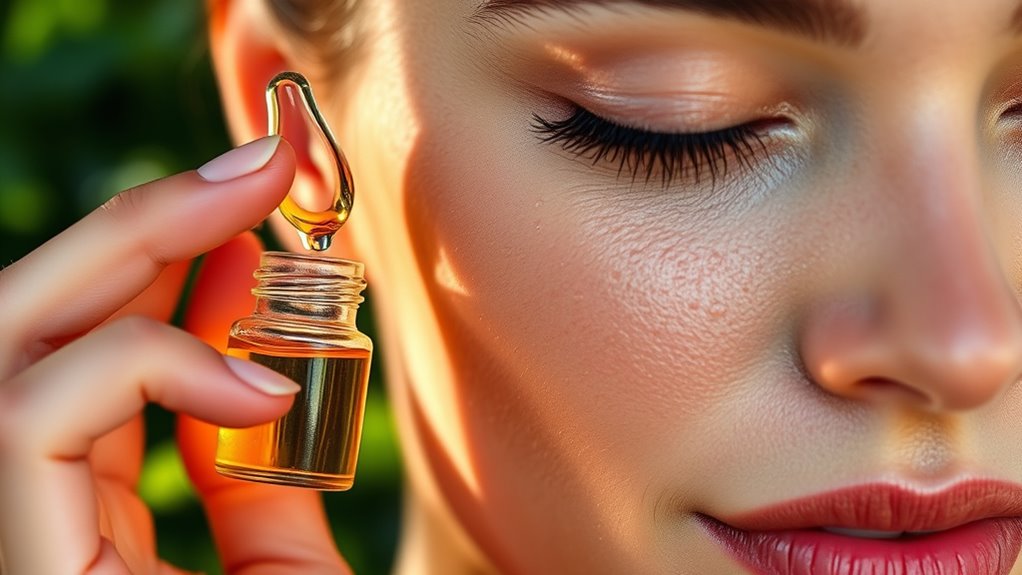
Have you ever wondered why your skin produces so much oil? It’s because your skin’s sebaceous glands are overactive, trying to keep up with environmental stressors and hormonal fluctuations. This excess oil can make your face look shiny and feel greasy throughout the day. You might notice enlarged pores, breakouts, and a persistent film on your skin’s surface. Oily skin often leads to a cycle of over-cleansing, which triggers even more oil production, making the problem worse. It’s not just about hygiene; it’s about balancing your skin’s natural functions. Understanding this process helps you see that oily skin isn’t a flaw, but a skin type with specific needs. The challenge is managing the oil without stripping your skin, which is where targeted skincare can help. Using facial oils formulated for oily skin can actually help regulate sebum production and improve skin health over time. Incorporating proper skincare routines tailored for oily skin can further support your skin’s balance and reduce excess oil.
The Role of Sebum in Skin Health

Sebum, the natural oil produced by your skin’s sebaceous glands, plays a vital role in maintaining your skin’s health. It acts as a protective barrier, locking in moisture and shielding against environmental damage. When sebum production balances, your skin feels smooth, resilient, and well-hydrated. However, excess sebum can clog pores, leading to breakouts, while too little causes dryness and irritation. Imagine your skin as a well-oiled machine:
| Excess Sebum | Not Enough Sebum |
|---|---|
| Clogs pores | Skin feels tight and flaky |
| Causes acne | Loses hydration |
| Dull appearance | Increased sensitivity |
| Enlarged pores | Reduced barrier function |
| Infections risk | Impaired healing |
Understanding sebum’s role helps you manage oily skin without stripping it, promoting a healthier balance.
Common Misconceptions About Facial Oils and Oily Skin
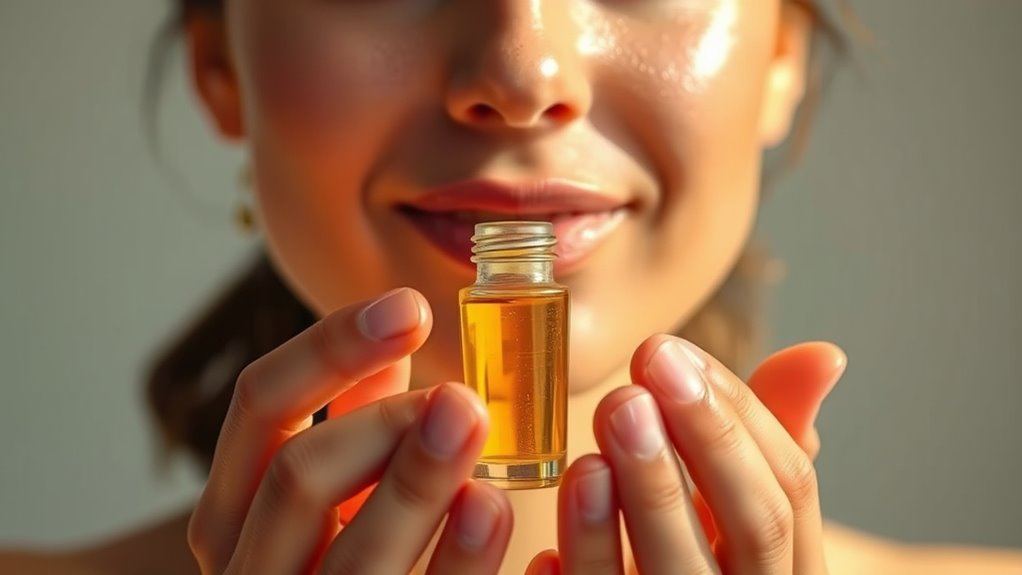
Many people believe that facial oils clog pores, but the truth is that proper oils can actually help keep them clear. You might think oily skin doesn’t need moisture, but skipping it can make your skin produce even more oil. Not all facial oils are the same; choosing the right one for your skin type is essential for balanced skin health. Additionally, selecting safe and compliant facial oils ensures you avoid irritation and maximize benefits. Using the correct self-watering plant pots can also contribute to healthier skin by maintaining consistent hydration, much like how proper plant watering supports growth. Incorporating automation tools such as appropriate motor power and battery capacity can help you better understand how to optimize your skincare routine’s effectiveness and sustainability.
Oils Do Not Clog Pores
Despite common beliefs, facial oils do not necessarily clog your pores. In fact, many oils are non-comedogenic, meaning they won’t block your pores or cause breakouts. It’s a misconception that applying oil will turn oily skin into a shiny, blemish-prone mess. Your skin needs oils to maintain a healthy barrier and regulate oil production. When choosing facial oils, look for those labeled non-comedogenic, such as jojoba, argan, or squalane. These oils mimic your skin’s natural sebum and are less likely to clog pores. Using the right oil can actually help balance your skin, reduce excess oil, and prevent breakouts. The key is selecting lightweight, non-irritating oils that support your skin’s health without contributing to congestion. Additionally, understanding your skin’s natural sebum production can help you select the most suitable oils for your needs. Recognizing the importance of dermatological testing can further ensure the safety and effectiveness of the oils you choose. Incorporating oil-based skincare correctly can enhance hydration without adding to oiliness or breakouts. Proper knowledge of skin type compatibility can assist in choosing oils that work harmoniously with your skin, especially when considering formulations tested for dermatological safety.
Oily Skin Needs Moisture
A common misconception is that oily skin doesn’t need extra moisture, but in reality, your skin can become dehydrated even if it produces excess oil. When your skin lacks hydration, it may overcompensate by producing more oil, leading to breakouts and shine. Moisture is essential for maintaining a healthy skin barrier, which helps regulate oil production and prevents dryness. Using lightweight, non-comedogenic moisturizers or facial oils can replenish hydration without clogging pores. Ignoring moisture needs can make your skin worse, causing increased oiliness and irritation. Proper hydration balances your skin’s oil levels and enhances its overall health. Additionally, understanding the benefits of wood-burning stoves and other heating options highlights how different factors influence the effectiveness and efficiency of heating systems, which can be analogously applied to skincare formulations and their effects. Ensuring your skin receives adequate hydration can prevent overproduction of oil and support a clearer complexion. Maintaining proper skin barrier function is crucial for overall skin health and oil regulation. Recognizing that over-washing can strip natural oils and exacerbate dehydration is also important for managing oily skin effectively.
All Facial Oils Are Same
Are all facial oils created equal? Not at all. Many believe any oil will clog pores or make oily skin worse, but that’s a misconception. Different oils have unique properties suited for various skin types. For example:
- *Jojoba oil* closely mimics your skin’s natural sebum, balancing oil production.
- *Argan oil* absorbs quickly, hydrating without greasiness.
- *Tea tree oil* offers antibacterial benefits, helping reduce breakouts.
Some oils, like *tea tree oil* and *argan oil*, contain properties that support skin health and can help manage oily skin effectively.
Using the right oil can actually help regulate oil production and improve your skin’s health. It’s a common myth that all facial oils are the same or that they’ll make oily skin worse. In reality, choosing the appropriate oil tailored to your skin type can be a game-changer.
How Facial Oils Help Regulate Oil Production

Facial oils can actually help balance your skin’s sebum levels, preventing excess oil buildup. When used correctly, they reduce the risk of oil spikes that cause breakouts. By restoring your skin’s natural equilibrium, facial oils keep your oily skin in check and looking healthier. Using the right type of oil for your skin type is essential to avoid worsening oiliness. Additionally, choosing trustworthy AI technology for skincare advice can ensure you receive reliable information tailored to your needs. Incorporating data privacy challenges into your research can help you make more informed decisions about product recommendations. Understanding skincare product ingredients and their effects can further optimize your skincare routine to better manage oily skin. Moreover, exploring innovative local culinary experiences like those at Culinaria De Gustibus Bistro and Osteria Del Teatro can inspire a holistic approach to self-care and wellness.
Balances Sebum Levels
Because oily skin produces excess sebum, it might seem counterintuitive to use facial oils, but these products can actually help regulate your skin’s oil levels. Facial oils work by signaling your skin to slow down sebum production, creating balance. When you apply the right oil, it tells your skin it’s hydrated enough, reducing the need to produce more oil. Imagine your skin as a busy factory, where a well-chosen oil acts like a manager, calming overactive oil glands. Visualize these effects:
- A gentle stream of oil soothing overactive glands
- Your skin’s surface becoming less greasy throughout the day
- Reduced need for harsh, drying products
This balance helps prevent excess oil buildup while keeping your skin properly hydrated and healthy.
Prevents Overproduction Spike
When your skin senses it’s adequately hydrated from facial oils, it’s less likely to react by producing excess sebum. This stability prevents sudden oil spikes that can lead to breakouts and shine. Facial oils work by signaling your skin that it doesn’t need to overproduce oil, helping to keep your skin balanced. When your skin feels nourished, it doesn’t send emergency signals to produce more oil to compensate. This controlled response reduces the risk of oily flare-ups and maintains a healthier complexion. Additionally, understanding how skin signaling influences oil production can help you choose the right skincare routine for balanced, healthy skin.
Restores Skin Equilibrium
Ever wonder how facial oils can help your skin find its natural balance? When used correctly, they can regulate oil production and restore harmony to your skin. Facial oils communicate with your skin’s glands, signaling them to produce just the right amount of oil. This prevents the cycle of overproduction and dryness, keeping your skin balanced. Imagine your skin as a scale that’s been tilted — facial oils help level it out. Think of these oils as a reset button, calming excess oil or dryness. They:
- *Soothe inflamed skin*, reducing redness and irritation.
- *Control excess oil* without stripping moisture.
- *Reinforce your skin’s barrier*, making it less reactive to triggers.
The Benefits of Non-Comedogenic Oils for Oily Skin

Non-comedogenic oils are a smart choice for oily skin because they won’t clog your pores or trigger breakouts. These oils are lightweight and formulated to prevent the formation of comedones, which cause blackheads and pimples. Select the right oils by looking for labels indicating non-comedogenic properties, ensuring compatibility with your skin type. By using non-comedogenic options, you help maintain clear skin and reduce excess oil production without stripping your skin’s natural barrier. They can balance your skin’s oil levels, providing hydration without adding greasiness. Many non-comedogenic oils contain anti-inflammatory and antioxidant properties, helping to calm irritation and protect against environmental damage. This makes them ideal for oily, acne-prone skin. Incorporating these oils into your skincare routine can improve overall skin health, leaving your face feeling balanced, refreshed, and less prone to breakouts. Additionally, understanding water-based solutions can help you better select ingredients that complement your skin type. Recognizing the benefits of Vacuums for Pet Hair can also inspire you to keep your living space cleaner, reducing allergens that may irritate sensitive skin.
Choosing the Right Facial Oil for Your Skin Type

Choosing the right facial oil depends on understanding your skin type and its unique needs. If you have oily skin, look for lightweight, non-greasy oils that won’t clog pores. For dry skin, opt for richer, deeply moisturizing oils that replenish moisture. Sensitive skin requires gentle, calming oils free from irritants. To help you decide, consider these options:
- Jojoba oil – mimics your skin’s natural sebum, balancing oil production.
- Tea tree oil – offers antimicrobial benefits, ideal for oily, acne-prone skin.
- Argan oil – lightweight and hydrating, suitable for sensitive or combination skin.
Incorporating Facial Oils Into Your Skincare Routine
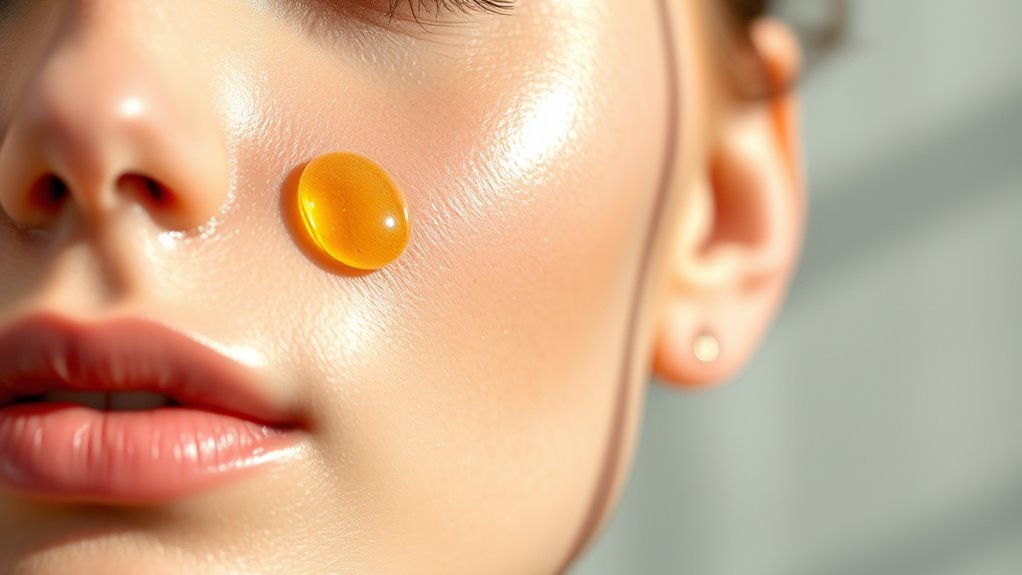
To effectively incorporate facial oils into your skincare routine, start by cleansing your skin thoroughly to remove dirt and excess oil. After drying, apply a few drops of the facial oil onto your fingertips and gently pat it onto your face. Focus on areas prone to oiliness or dryness, depending on your skin’s needs. Use the oil after cleansing and before moisturizer, allowing it to absorb fully. If you’re new to facial oils, start with a small amount to see how your skin reacts. You can also mix a few drops into your moisturizer for added hydration without feeling greasy. Consistency is key; incorporate facial oils daily or a few times a week to experience their balancing benefits over time.
Real Results: Success Stories and Testimonials

Many people have shared impressive results after incorporating facial oils into their oily skin routines. They’ve experienced clearer, less greasy skin and a balanced complexion. For example, some users report their skin feels less oily by midday, while others notice fewer breakouts and reduced shine. Here are some success stories:
- A woman found her skin became smoother and more radiant after just two weeks, with fewer blackheads and pimples.
- A man experienced significant oil reduction, leading to a matte finish that lasted all day.
- A young adult noticed their skin felt more hydrated without clogging pores, resulting in a healthier glow.
These testimonials show that facial oils can truly transform oily skin, turning it into a balanced and vibrant complexion.
Tips for Maintaining Balanced and Healthy Oily Skin

Maintaining balanced and healthy oily skin requires a consistent skincare routine that targets excess oil without stripping moisture. Start by cleansing twice daily with a gentle, oil-free cleanser to remove dirt and excess sebum. Incorporate a lightweight, oil-free moisturizer to keep your skin hydrated without clogging pores. Using a toner with ingredients like salicylic acid can help control oil and prevent breakouts. Don’t skip sunscreen; choose a matte-finish, non-comedogenic formula to protect your skin without adding shine. Regularly exfoliate with a chemical exfoliant to remove dead skin cells and prevent clogged pores. Ultimately, avoid touching your face and picking at blemishes, which can worsen oiliness and irritation. Consistency is key to balancing your skin and maintaining its health.
Frequently Asked Questions
Can Facial Oils Cause Breakouts for Oily Skin Types?
You might wonder if facial oils will cause breakouts for oily skin. It’s understandable to be cautious, but not all oils clog pores. Look for non-comedogenic oils like jojoba or argan, which balance oil production without causing breakouts. Using the right oil in moderation can actually help regulate your skin’s oil levels and reduce acne. Always patch test and choose products suited for oily skin to prevent breakouts.
Are There Specific Ingredients to Avoid in Facial Oils for Oily Skin?
Like Pandora’s box, some ingredients can unexpectedly worsen your oily skin. Avoid facial oils with heavy, comedogenic ingredients like mineral oil, coconut oil, and lanolin, which can clog pores. Steer clear of alcohol-based oils and synthetic fragrances that might irritate your skin. Instead, look for lightweight, non-comedogenic oils like jojoba, squalane, or grapeseed oil to balance your skin without causing breakouts.
How Often Should I Apply Facial Oil if I Have Oily Skin?
You should apply facial oil once or twice daily if you have oily skin. Typically, after cleansing and toning, put a few drops onto your face, focusing on areas that need extra hydration. Don’t overdo it, as too much oil can clog pores and increase oiliness. Stick to a light application, and adjust based on how your skin responds. Consistency helps balance your skin’s oil production over time.
Do Facial Oils Work Differently for Different Skin Tones?
You wonder if facial oils work differently for various skin tones. The truth is, they can, depending on your skin’s unique needs. Lighter oils like jojoba or rosehip suit most skin tones, helping balance oil production without clogging pores. Darker or more sensitive skin may require gentler formulas. Pay attention to how your skin reacts, and choose oils that match your skin tone and concerns for best results.
Can Facial Oils Replace My Regular Moisturizer for Oily Skin?
Think of facial oils as a double-edged sword—you might cut through excess oil while nourishing your skin. For oily skin, replacing your moisturizer isn’t always necessary. Instead, try using a lightweight, oil-based moisturizer or applying facial oil after cleansing to balance your skin’s oil production. Listen to your skin’s signals—if it feels greasy or tight, adjust accordingly. Facial oils can complement, but not necessarily replace, your usual skincare routine.
Conclusion
So, next time you reach for that matte primer, consider giving facial oils a shot. Who knew that adding a little oil could actually help tame your greasy complexion? It’s like trying to outsmart your skin—think of it as a secret weapon, not a villain. Embrace the paradox, because your oily skin might just thank you by finally behaving. Who said skincare wasn’t a little bit of magic?
